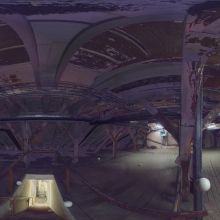Muyu Liu
HDR Image Improvement of Terrestrial Laser Scanning
Duration of the Thesis: 6 months
Completion: October 2019
Supervisor: Prof. Dr.-Ing. Norbert Haala, Dr. Richard Steffen, M.Sc. Martin Graner (PointCab)
Examiner: Prof. Dr.-Ing. Norbert Haala
Introduction
Capturing natural scenes under unfavorable light conditions generally results in overexposed and underexposed areas in images due to the issue of the limited dynamic range imaging. The ordinary solution is to introduce a method high dynamic range imaging HDRI: Several RGB images of different exposures are combined into one image with a greater dynamic range. However, this is not often achievable either with ordinary cameras or unprofessional photographers. Instead of multiple exposure photography, we propose a novel algorithm based on the combination of laser scanning intensity image and corresponding RGB image, while most 3D laser scanners record the panoramic scenes simultaneously. Thus, we acquire materials without additional equipment or experiment.
Proposed Method
We propose an image improvement method based on laser scanning images. We use the laser scanning information as the guidance to derive the color information from the neighborhood and furthermore superimpose the intensity information onto this new derived color to reproduce the patterns as well. In the end, we have the resulting image with the true color–grown from the coherence field–as well as the detailed patterns–captured from laser scanning intensity image.
- Structured features are well reproduced at all scale levels. Color transport works in a large range of areas, from small details to huge vacant areas. Structures can be produced on the base of intensity images exclusively.
- Targets are ruined after the procedure. We destroy the boundaries in under-/overexposed parts if the boundary does not appear in the intensity image. An unsuitable threshold range of the mask leads to side effects at the edges of the mask.
The results show that our novel combination approach obtains pleasant results with natural color and abundant details. Structured features are well reproduced and natural color is generated through a variable distance. These results have been proved statistically containing more information on the over-/underexposed areas and significantly improved for display but the limit of our method is obvious and a expand research based on existing method is valuable in the future work.
Ansprechpartner

Norbert Haala
apl. Prof. Dr.-Ing.Stellvertretender Institutsleiter






